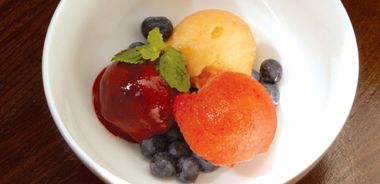Fresh Fruit Sorbet

The key to a great sorbet lies in the fruit; it must be ripe and prepared accordingly. For example, a melon sorbet requires peeled and seeded melon; strawberries should be washed and de-stemmed; blueberries, raspberries, and blackberries are usually good to go.
1 cup (250 mL) water
1 cup (250 mL) sugar
4 cups (1 L) ripe fruit
2 Tbsp (30 mL) lemon juice
Make a simple syrup by dissolving the sugar into boiling water; stir in lemon juice and desired fruit and remove from heat. Let sit for 5 minutes before pureing in blender or food processor. Freeze according to the directions on the ice cream maker.
While it is possible to make a sorbet without an ice cream maker by taking the mixture out of the freezer every hour or so to manually break up the ice crystals, this is both time consuming and no guarantee of texture. An inexpensive machine ($40 and up) will make simple work of any sorbet.
source: "SOBO's Sophisticated Bohemians", alive #304, February 2008




